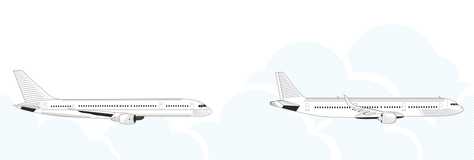Future flight / New York
Awaiting take-off
Speculation about the future of the Boeing 757 fleet and a forthcoming replacement is mounting but vital airframers think they have a strategy to fill the single-aisle jet’s spot in the market. Here’s our take on the 757 and Airbus’s attempt to unseat Boeing from its lofty vantage point.

In 2005, Boeing dispatched final orders for its 757, a jet that packs a punch when it comes to range and passenger capacity, occupying a spot between much smaller single-aisle jets and harder-to-fill widebodies. It has long been a favourite with airlines servicing routes across the North Atlantic. But as much of the 757 fleet is fast approaching retirement, operators are facing a dilemma: what can they order to replace this workhorse? Will Boeing be tempted to revive it?
In 2014, Boeing Commercial Airplanes spokesperson Doug Alder told us, “Although our product development strategy is set for the next decade, we have always been focused on making investments that keep us ahead of our competitors.” It sounds like he’s leaving himself some room to manoeuvre.
And why wouldn’t he? Since it took to the skies with British Airways and Eastern Airlines in 1983, the 757, with its long fuselage, unique cabin configuration and enviable range, has filled a special niche for carriers around the world. United and American’s 757s, for example, allow them to cross the Atlantic and serve markets that wouldn’t be able to sustain daily services that used a wide-body aircraft. For former US secretary of state Hillary Clinton, her special-mission 757 captured more airtime during her tenure than Air Force One.
Alder is perhaps wary that rival Airbus could see Boeing’s strategy of sticking with its current plans as an opportunity for it to steal some territory. A longer-range a321neo would be Airbus’s chance at finding a place in the market of which Boeing might be jealous. The European maker is even a bit feisty when discussing the potential of a beefed-up a321neo to take the place of the 757. “With the long-range version of the a321neo currently under study, the rationale for continuing 757 operations has vanished,” says Patrick Baudis, VP of marketing at Airbus Americas. While passenger and range numbers don’t put the Airbus level with the 757, a modified version of the a321neo could kill the idea of a new 757.
There’s a good reason why Airbus would consider simply modifying the a321neo instead of designing a new jet: a lot of cash has already been spent on all-new aircraft programmes. “The a380 is horribly irrelevant and probably doomed,” says Teal Group’s VP of analysis Richard Aboulafia, in reference to its less than exemplary order numbers and the finite number of routes on which the jet makes financial sense. He adds, “The 787 is exceedingly popular but [programme] profitability is another story.” So naturally, at this point airframers are wary of anything built from scratch.
Boeing seems satisfied by its ability to capture demand for higher-capacity single-aisle jets with the tried and tested 737. It is the most-produced jet in the world. More than 8,000 have rolled off Boeing’s production line and by 2020 they will continue to do so with the 737 Max family, equipped with new engines and updated engineering.
Global demand for single-aisle jets is staggering: both makers predict total orders of over 20,000 during the next 20 years. the forecast expects that most of this demand will be met by the a320 and 737 families that have been updated for efficiency. We like the 757. While we wouldn’t choose it over a well-appointed and wider Boeing 777 on a flight across the Atlantic, we do think it has its place on flights up to seven hours.
When Boeing discontinued the 757 the industry wondered what carriers such as Icelandair might do. The Reykjavík brand relies on the 757 for its scheduled flights as the airline’s hub in Keflavík sits at the ideal halfway point for a jet like the 757 to be used to its potential: serving cities across North America and western Europe. Although the company has ordered the new 737 Max, are these smaller jets the right solution? We would even wager that a true 757 replacement from Airbus might tip the all-Boeing Icelandair into the Airbus camp. Executives at the two makers are surely aware of this.
The past decade is littered with attempts to launch premium, one-class services between cities on America’s East Coast and western Europe. The economics on these routes are tough but the key to those that have been successful is the 757. These operators will also be keen to see a true 757 replacement.
The hunch is that airlines will fly the 757 long into the future, with plenty of maintenance, unless Airbus finds a way to make the a321neo fill the niche. Aboulafia thinks another whole new aeroplane would be a stretch: “Airbus and Boeing need to execute on their numerous new programmes without the kind of horrible cost overruns we’ve seen in the past.” But were another new programme to emerge from the aerospace giants, say an a360 or a 797, what might it look like?
In terms of design, a Boeing 757 replacement would be simple and mimic what airlines love about the jet: that ability to profitably fly routes that bigger jets can’t and its operational commonality with other planes from the company. In short, if it happens, don’t expect it to be radically different from its predecessors. In anything new we will likely see a focus on better materials, more efficient engines and enhanced passenger comfort.


